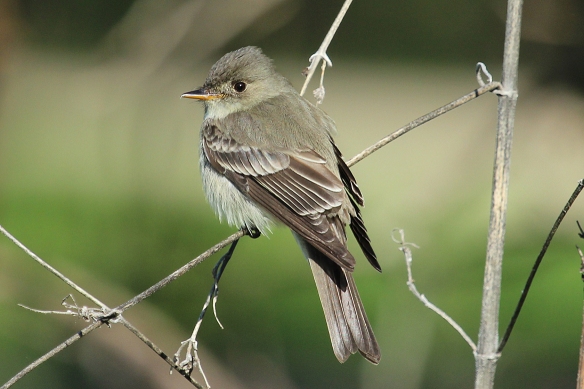Even though it was chilly and overcast yesterday, the backyard was humming with visitors.
While the Yellow-rumped Warblers swarmed the suet feeders (as many as 8 on the feeder at one time), the Baltimore Oriole and his girlfriend (?) monopolized the oranges, a Least Flycatcher, a Swainson’s Thrush, and an Ovenbird perched near the garden hunting the dead mealworms I had thrown there, and an Indigo Bunting and a pair of Rose-breasted Grosbeaks tapped into the seed feeders. It was hard to get anything done while looking out the window every couple of minutes.

This Indigo Bunting is as bright blue as his cousin the Cardinal is red. At least they have the bright colors in common. Buntings are probably the smallest member of the Cardinal family, and sing a much prettier song than Cardinals do.
Like other small songbirds, Indigo Buntings migrate north in the spring at night, using the stars to navigate their way. You can read more about how their navigational abilities were discovered in an earlier blog post.

Least Flycatchers may be small but they are obviously successful because they are one of the most common flycatchers seen in the northern U.S. They dart out from a favorite perch over and over, chasing small insects.

I have never seen an Ovenbird in the backyard before. Perhaps it saw how much the Flycatcher was enjoying the mealworms and decided to get a few for itself before moving on. Their striped breast and bright rusty crown stripe make them easy to recognize.
Ovenbirds are grouped with the Warblers, but they certainly don’t act like them. Instead of flitting around in the tree tops, these little birds search through the litter of the forest floor picking up small insects and other invertebrates. They might be hard to spot among the dense vegetation of the forest, but their loud, repetitive call, “tee-cher, tee-cher, tee-cher” alerts you to their presence. The female weaves a globe of grass and twigs, kind of resembling a Dutch oven, for her nest — hence their common name.

Swainson’s Thrush may be a plain brown bird with a few streaks down its breast and a buffy ring around its eye. but like other thrush species (except Robins) it has a very melodious song.
More often heard than seen, Swainson’s Thrush can be really difficult to locate in a dense forest as they hide behind vegetation and face in several different directions to sing. Territorial males can get so antagonistic toward each other, they engage in a sing-off, each producing louder and louder cascades of flute-like sound, spiralling up or down the scale.
Part of the reason so many birds are congregating in the backyard right now is because of the delay in warm spring weather in the upper Midwest. Early, mid, and late arriving migrants are stacked up here, waiting for that warm front from the Gulf that will carry them north on the final leg of their migration. Meanwhile, I feel like I’m back in the tropics, with a huge diversity of birds flitting around in the backyard. Most likely, that will end soon.


I didn’t realize that ovenbirds were grouped with warblers – they look so much like some sort of thrush. And I can so relate with getting sidetracked looking out windows!
Some of the serious birders think Ovenbirds don’t belong with warblers, but perhaps in their own group with the water thrushes (also currently grouped with warblers). I guess we have to await the results of the DNA tests to determine just who they really are most closely related to.
The bad weather stalled the migrants here too, but oh, how wonderful to have them stay a few days in your backyard!
Yes it is wonderful to have such diversity in the backyard, kind of like living in Florida, without the hurricanes! 😀
From what I saw of the weather forecast today it looks like your visitors might be staying for a while yet.
My guess is they will leave this weekend, our first warm days in quite a while (since Easter). Some new migrants might arrive though, and the leaves have been held back with cold temps as well. So perhaps another good week of birding?
I never realized that indigo buntings were so brightly colored , having never seen one myself. Your shots of the different birds are really good–you managed to isolate them well and captured great detail. If that day qualifies as “crazy,” I think I might prefer it over “normal.”
It’s that blue structural color thing–like bluebirds, you have to see them in just the right light. Their heads in particular are a very deep indigo. Older, more studly males are probably the brightest of the group. With the exception of the flycatcher, all of those photos were taken through my porch windows looking out into the backyard bird feeders. The action out there was pretty intense!